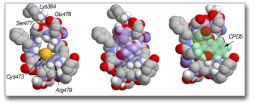
Contact
1407 CHVRNPittsburgh, PA 15260
412-624-8270
My Website >
Research Overview
New Methods for Chemical Discovery; New Reactions; Models for Protein Folding; Precipitons; Molecular Torsion Balance; Physical Organic Chemistry of Solid Phase Synthesis
Chemical Separation
 Imagine - after a homogeneous reaction is complete, the chemist adds a catalyst or exposes the reaction mixture to soft UV light and pure product precipitates from the reaction mixture. This can be achieved with "precipitons" - protecting groups that have controllable solubility states. The Wilcox group has reported the first advances toward that goal.
Imagine - after a homogeneous reaction is complete, the chemist adds a catalyst or exposes the reaction mixture to soft UV light and pure product precipitates from the reaction mixture. This can be achieved with "precipitons" - protecting groups that have controllable solubility states. The Wilcox group has reported the first advances toward that goal.
The precipiton method has now been applied to several chemical reactions. Because products can be isolated in high purity without extraction, distillation, or chromatography, the amount of solvent needed for a process may be reduced by more than 90%.
 The precipiton method also provides a new method for catalyst recovery in soluble polymer synthesis. Homogeneous catalysis by metal complexes can lead to discolored polymer products. The precipiton method allows catalysts to be removed by filtration. The picture at right shows a solution of cuprous bromide and precipiton scavenger before (left) and after (right) exposure to 350 nm light.
The precipiton method also provides a new method for catalyst recovery in soluble polymer synthesis. Homogeneous catalysis by metal complexes can lead to discolored polymer products. The precipiton method allows catalysts to be removed by filtration. The picture at right shows a solution of cuprous bromide and precipiton scavenger before (left) and after (right) exposure to 350 nm light.
 Meso-scale Synthesis. Polystyrene microspheres (1-50 micron diameters) are commercially available. The Wilcox group has developed methods for creating small covalently bonded chemical patches on the surface of microspheres. For example (right), 10 micron spheres have been labeled with 2 micron patches of fluorescent dye. These unique anisotropic materials can be used as building blocks for larger functional devices.
Meso-scale Synthesis. Polystyrene microspheres (1-50 micron diameters) are commercially available. The Wilcox group has developed methods for creating small covalently bonded chemical patches on the surface of microspheres. For example (right), 10 micron spheres have been labeled with 2 micron patches of fluorescent dye. These unique anisotropic materials can be used as building blocks for larger functional devices.
Meso-Scale Synthesis
 Polystyrene microspheres (1-50 micron diameters) are commercially available. The Wilcox group has developed methods for creating small covalently bonded chemical patches on the surface of microspheres. For example (right), 10 micron spheres have been labeled with 2 micron patches of fluorescent dye. These unique anisotropic materials can be used as building blocks for larger functional devices.
Polystyrene microspheres (1-50 micron diameters) are commercially available. The Wilcox group has developed methods for creating small covalently bonded chemical patches on the surface of microspheres. For example (right), 10 micron spheres have been labeled with 2 micron patches of fluorescent dye. These unique anisotropic materials can be used as building blocks for larger functional devices.
Drug Discovery and Molecular Recognition
 Phosphatase enzymes play an important role in cell cycle regulation. We continue to test new electrophiles as active site directed inhibitors of dual-specificity phosphatase and tyrosine phosphatase enzymes. We have molecules that show sub-micromolar activity against cdc25b and that also inhibit tumor cell growth.
Phosphatase enzymes play an important role in cell cycle regulation. We continue to test new electrophiles as active site directed inhibitors of dual-specificity phosphatase and tyrosine phosphatase enzymes. We have molecules that show sub-micromolar activity against cdc25b and that also inhibit tumor cell growth.
Field Effects and Reaction Control
 Electrostatic fields from ion pairs in nonpolar solvents or in hydrophobic environments can have a very useful effect on chemical reaction rates and specificity. We have demonstrated rate accelerations of up to 450-fold. The use of tethered ion pairs for increasing the stereoselectivity of reactions has been demonstrated. We are now investigating the use of ion pairs in forming chiral environments for asymmetric synthesis.
Electrostatic fields from ion pairs in nonpolar solvents or in hydrophobic environments can have a very useful effect on chemical reaction rates and specificity. We have demonstrated rate accelerations of up to 450-fold. The use of tethered ion pairs for increasing the stereoselectivity of reactions has been demonstrated. We are now investigating the use of ion pairs in forming chiral environments for asymmetric synthesis.